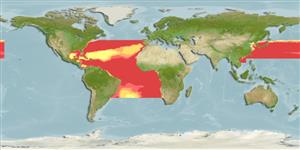Teleostei (teleosts) >
Myctophiformes (Lanternfishes) >
Myctophidae (Lanternfishes) > Diaphinae
Etymology: Diaphus: Greek, dis, dia = through + Greek, physa, phyo = to beget, to have as offspring (Ref. 45335).
More on author: Norman.
Environment: milieu / climate zone / depth range / distribution range
Ecology
Marine; bathypelagic; depth range 40 - 475 m (Ref. 4479). Deep-water; 42°N - 27°S
Eastern Atlantic: Mauritanian Upwelling region and Gulf of Guinea south to 23°S. Western Atlantic: USA (Gulf Stream) to Gulf of Mexico and the Caribbean Sea. Northwest Atlantic: Canada (Ref. 5951). Reported off the Guianas (Ref. 13608).
Length at first maturity / Size / Weight / Age
Maturity: Lm 3.8, range 4 - 4 cm
Max length : 7.0 cm SL male/unsexed; (Ref. 4479)
Pseudoceanic, found over continental shelves and slopes (Ref. 4066). Occurs between 325-475 m during the day; between 40-250 m at night (maximum abundance in 100 m depth). Mesopelagic (Ref. 5951). In the Cariaco Trench, day distribution is at 250 m and at night at 50 m due to anoxic conditions below 400 m and free hydrogen sulphide below 375 m. Fecundity is about 1,000 eggs per female (Ref. 9504).
Life cycle and mating behavior
Maturities | Reproduction | Spawnings | Egg(s) | Fecundities | Larvae
Hulley, P.A., 1990. Myctophidae. p. 398-467. In J.C. Quero, J.C. Hureau, C. Karrer, A. Post and L. Saldanha (eds.) Check-list of the fishes of the eastern tropical Atlantic (CLOFETA). JNICT, Lisbon; SEI; Paris; and UNESCO, Paris. Vol. 1. (Ref. 4479)
IUCN Red List Status (Ref. 130435)
Threat to humans
Harmless
Human uses
Tools
Special reports
Download XML
Internet sources
Estimates based on models
Preferred temperature (Ref.
123201): 11.1 - 23.6, mean 17.9 °C (based on 395 cells).
Phylogenetic diversity index (Ref.
82804): PD
50 = 0.5000 [Uniqueness, from 0.5 = low to 2.0 = high].
Bayesian length-weight: a=0.01000 (0.00436 - 0.02294), b=3.04 (2.86 - 3.22), in cm total length, based on LWR estimates for this Genus-body shape (Ref.
93245).
Trophic level (Ref.
69278): 3.3 ±0.2 se; based on diet studies.
Resilience (Ref.
120179): High, minimum population doubling time less than 15 months (Preliminary K or Fecundity.).
Fishing Vulnerability (Ref.
59153): Low vulnerability (10 of 100).
